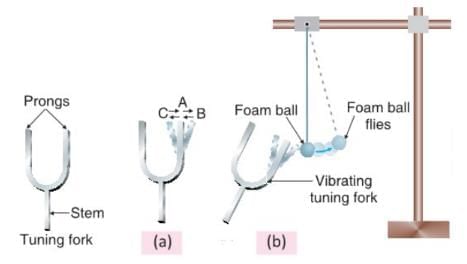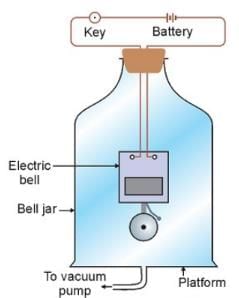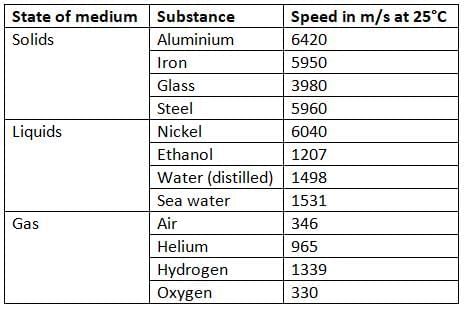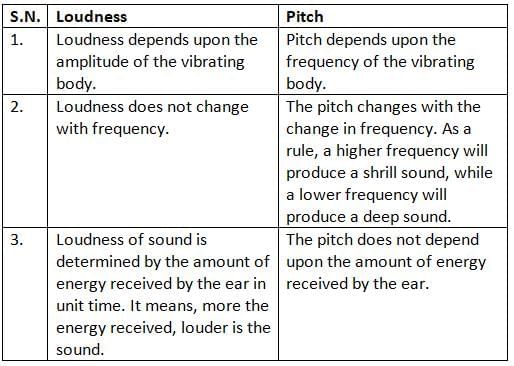Sound Chapter Notes | Physics for ENGAA PDF Download
| Table of contents |

|
| Introduction |

|
| Sound, its production and propagation |

|
| Reflection and Characteristics of Sound |

|
| Points To Remember |

|
| Glossary |

|
Introduction
Sound is all around us, and we hear it every day! It can be the bark of a dog, the noise of a scooter, or even our own voice. In this chapter, we will learn how sound is made, how it travels, and why we can hear it. We will also find out how sound moves faster or slower in different things like air, water, or iron, and why we need something like air or water for sound to travel. Let’s explore the exciting world of sound!
Sound, its production and propagation
Sound as longitudinal wave
- Sound is made when something shakes or vibrates.
- When something vibrates, it makes the air around it move in a special way, called a wave.
- This wave is called a longitudinal wave because the air particles move back and forth in the same direction as the wave is going.
- In a longitudinal wave, the air gets squeezed (called compression) and then spreads out (called rarefaction), and this keeps happening one after the other.
- These waves carry the sound energy forward.
- Sound waves in air are longitudinal waves because the air particles move back and forth in the same direction as the wave.
- There is another type of wave called a transverse wave, where the particles move up and down, not back and forth, but sound waves are not like that.
- Longitudinal waves can happen in solids (like iron), liquids (like water), and gases (like air).
Vibrations are the cause of sound
- Sound happens because something vibrates, which means it moves back and forth quickly.
- Anything that makes sound is vibrating, like a ruler, a tuning fork, or even your voice.
Tuning fork
- A tuning fork is a U-shaped steel tool with two arms called prongs and a handle called the stem.
- It is used in labs to make sound for experiments.
- To do an experiment with a tuning fork, take a small foam ball and hang it from an iron stand with a light silk thread.
- Hit one prong of the tuning fork on a hard rubber pad and bring it near your ear.
- You will hear a sharp humming sound because the prong is vibrating.
- Now, touch the foam ball with the vibrating prong of the tuning fork.
- You will see the foam ball move outward because the prong is vibrating.
- This experiment shows that the sound from a tuning fork happens because its prongs vibrate.

For hearing following conditions are necessary
- There should be something that vibrates to make the sound, like a tuning fork or a bell.
- The material around the vibrating thing, like air, liquid, or solid, should also vibrate because of those vibrations.
- There should be something to hear the sound, like our ears, to receive and understand the vibrations.
Note:
- You can find out if a train is coming or not even if the train is not visible to you.
- Put your ear on the railway tracks, and if the sound of the train is heard, it means the train is coming.
- The sound of the train travels through the rails and reaches your ear.
- If the sound gets louder, it means the train is getting closer.
- If the train is moving away, the sound gets softer because the loudness decreases as the train moves farther.
- The reason the sound travels so fast is that the rails are made of steel, and sound travels very fast in solids, around 5,100 meters per second.
- People used this method to find out if an enemy was coming or not, like checking if the sound of horses’ hooves was getting louder to know if the enemy was near.
Sound needs a medium to transmit
- We know that sound can travel through solids, liquids, and gases.
- In other words, sound needs a material medium to travel, like air, water, or steel.
- To prove this, let’s do an experiment.
- Take a bell jar and put an electric bell inside it.
- Place the bell jar on the platform of a vacuum pump and make the setup airtight.
- Connect the bell to a battery through a key (push button switch).
- Press the key, and you will hear the sound of the bell because there is air inside the bell jar, and the hammer of the bell is striking the gong.
- Now, start the vacuum pump to remove the air from the bell jar.
- You will notice that as the air is removed, the loudness of the bell’s sound decreases.
- Finally, when a vacuum is created (no air is left), no sound is heard, even though the hammer is still striking the gong.
- This experiment proves that sound cannot travel in a vacuum.
- It also proves that a material medium, like air, is needed for sound to travel.

Note:
- The approximate speed of sound in air is 332 meters per second.
- The speed of sound in water is 1,500 meters per second.
- The speed of sound in iron or steel is 5,100 meters per second.
Speed of sound in different media at 25°C

How to find the speed of sound in air
- To find the speed of sound in air, you need two tall buildings that are at least 1 km apart.
- Do this experiment at night when it’s dark.
- Two people are needed: one on building A and one on building B.
- Fix a time, like 11 p.m., for the experiment.
- The person on building A fires a gun at 11 p.m. and starts a stopwatch when they see the flash of the gun.
- The person on building B hears the sound of the gun and stops the stopwatch as soon as they hear it.
- The time between seeing the flash and hearing the sound is noted.
- Use this formula to find the speed of sound:
Speed of sound = Distance between the buildings ÷ Time interval
Why is the thunder heard after the flash of lightning?
- Light travels very fast at a speed of 3 × 10⁸ m/s (that’s 300,000,000 m/s).
- Sound travels much slower in air at 330 m/s.
- When lightning happens, you see the flash right away because light is so fast.
- But the sound of thunder takes more time to reach you because sound is much slower.
- That’s why you hear the thunder after seeing the lightning flash.
- You can use this to find the height of a cloud where lightning happens.
- Hold a stopwatch on a rainy day when you see lightning.
- Start the stopwatch when you see the lightning flash.
- Stop the stopwatch when you hear the thunder.
- Let’s say the time gap between the flash and thunder is 6.5 seconds.
- We know the speed of sound in air is 330 m/s.
- Use this formula to find the height of the cloud:
- Height of cloud = Distance travelled by sound
- Distance = Speed of sound in air × Time
- Distance = 330 m/s × 6.5 s = 2145 m
- So, the height of the cloud is 2145 meters.
Reflection and Characteristics of Sound
Some common terms used in sound
Sound has three main things:
- Amplitude:
- This is how far a vibrating thing moves from its middle position.
- The unit of amplitude is metre (m).
- In a string, the distance from the middle to the highest or lowest point is the amplitude.
- Frequency:
- This is how many vibrations a thing makes in one second.
- The unit of frequency is hertz (Hz).
- A German scientist named Heinrich R. Hertz found that 60 vibrations in one second is 60 Hz.
- Time period:
- This is the time taken for one full vibration.
- The unit of time period is second (s).
Relation between time period and frequency
Frequency (v) = 1 ÷ Time Period (T), or T = 1 ÷ v.
Note:
- In 1660s, Italian scientists Giovanni Alfonso Borelli and Vincenzo Viviani first found the speed of sound. They saw a flash of a gun and heard its sound after some time. They measured the time between seeing the flash and hearing the sound over a long distance on a still day. They found the speed of sound to be 350 metres per second.
- Never put a sharp pointed or hard object in your ear—it can damage the ear drum and harm hearing.
Do all vibrations produce sound?
- All vibrating things make sound, but we cannot hear all of them.
- Humans can hear sounds between 20 Hz and 20,000 Hz—this is called the audible range.
- Sounds below 20 Hz are called infrasonic or subsonic sounds.
- Sounds above 20,000 Hz are called ultrasonic sounds.
- Some animals like dogs can hear ultrasonic sounds.
- Dolphins also use ultrasonic sounds to find their prey.
Technical applications of ultrasonic sound
- Humans cannot hear sounds above 20,000 Hz, but we use them in many ways.
- Ultrasonic waves are used to study the growth of a baby in the mother’s womb.
- Ultrasonic waves help in mixing milk evenly (homogenising milk).
- Ultrasonic waves are used to find faults in metals and structures.
- Ultrasonic waves are very important in SONAR, which is used to find submarines, icebergs, sunken ships, and to map the sea floor.
- SONAR stands for Sound Navigation Ranging.
Uses of ultrasonic vibrations by animals
- Dogs:
- Dogs can hear sounds up to 40,000 Hz.
- Dogs can be trained to respond to an ultrasonic whistle, called Galton’s whistle, invented by Francis Galton.
- Galton’s whistle makes sounds between 16,000 Hz and 22,000 Hz, which dogs can hear but humans cannot.
- Bats:
- Some bats that eat insects can hear high-pitched sounds that humans cannot hear.
- Bats make high-pitched sound waves that bounce off objects in their path.
- The bounced sound (echo) tells the bat how far the object is.
- This helps bats fly in the dark and avoid hitting things in caves.
- Dolphins:
- Dolphins make sounds like grunts, chirps, and squeaks to talk to each other.
- Dolphins have a special system to find objects under water using sound, with great accuracy.
Reflection of sound
- When sound hits a hard surface, it bounces back in another direction—this is called reflection of sound.
- Sound follows two rules of reflection, just like light:
- Rule 1: The angle at which sound hits (angle of incidence) is equal to the angle it bounces back (angle of reflection).
- Rule 2: The incoming sound, the reflected sound, and the normal line are all in the same plane.
Absorption of sound (sound insulation)
- Hard things like mirrors, metals, or stones reflect sound well.
- Soft or porous things like wool, curtains, gunny bags, straw, or carpets absorb sound.
- Big cinema halls or auditoriums have carpets on the floor and walls to absorb sound.
- In places with hard walls, sound reflects a lot and makes echoes, which makes the sound unclear.
- In recording studios, walls and ceilings are covered with sound-absorbing materials to stop reflections.
- In normal rooms, sounds are not 17 m long, so the original and reflected sounds reach the ear at the same time, and no echo is formed.
Echoes
- An echo is when you hear a sound again after it bounces off a faraway object, like a hill or building.
- It takes 1/10 second for the exciting sound to stop in our ear—this is called persistence of audibility or hearing.
- So, it takes less than 1/10 second for a reflected sound to reach the ear after the original sound dies, and we cannot hear it as an echo.
- However, if the reflected sound reaches the ear after 1/10 second, we can hear it as an echo.
- For an echo to be heard, the minimum distance between the sound source and the reflecting object should be 17 m.
- The formula for minimum distance is: Minimum distance = (v × T) ÷ 2, where v is the speed of sound and T is time.
- Using speed of sound as 332 m/s and T as 1/10 second: Minimum distance = (332 × 1/10) ÷ 2 = 16.6 m, which is about 17 m.
Note:
- An echo can be heard only if there is a high-rise building or hill nearby.
- The minimum distance between the sound source and reflecting body should be 17 m for an echo to be heard.
- The loudness of the echo should be strong enough to be heard after reflection.
Sonar
- SONAR means Sound Navigation Ranging—it is used in ships or submarines to measure the depth of the ocean or find objects.
- A ship sends an ultrasonic sound wave towards the bottom of the ocean.
- The sound wave hits the ocean floor and bounces back to the ship’s receiver.
- The time taken by the sound to travel to the ocean floor and back is recorded.
- We use the formula to find the depth of the ocean floor: Depth = (Velocity of sound in sea water × Time) ÷ 2.
- Example: If it takes 2.4 seconds to record the echo and the speed of sound in sea water is 1450 m/s:
Depth of ocean floor = (1450 × 2.4) ÷ 2 = 1740 m.
Characteristics of a sound wave
Sound has amplitude, time period, and frequency, which decide how it sounds.
Loudness
- Loudness is a feature of sound that helps us know the difference between a soft sound and a loud sound of the same frequency.
- Loudness depends on the amplitude of the sound: the bigger the amplitude, the louder the sound.
- Some experiments show that loudness is related to the square of the amplitude of the vibrations making the sound.
- For example, if the amplitude becomes 3 times bigger, the loudness becomes 9 times bigger.
- If the amplitude becomes 4 times bigger, the loudness becomes 16 times bigger, depending on how much air vibrates.
- Loudness of sound is measured in a unit called decibel, written as dB.

Loudness of some sources given

- Loudness above 80 dB can harm your ears—it can be painful.
- The loudness of a sound depends on how much the body vibrates and the frequency.
- The pitch of a sound depends on its frequency—higher frequency means higher pitch, and lower frequency means lower pitch.
Note:
- Loudness gets bigger when the amplitude of the vibrating object increases.
- Loudness gets bigger when the surface area of the vibrating object increases.
- Loudness gets smaller when the distance from the sound source increases.
Pitch
- Pitch is the feature of sound that depends on frequency.
- Frequency is also an important feature of sound because different frequencies make sounds with different pitches.
- You might have noticed the difference between the sound of a baby’s voice (shrill) and an adult’s voice (deep).
- The shrillness or pitch of a sound depends on the frequency of the vibrating object.
- A higher frequency makes a sound with a higher pitch, and a lower frequency makes a sound with a lower pitch.
- A high-pitched sound seems shrill, and a low-pitched sound seems deep to our ears.
- Examples:
- The voice of a child or a woman has a higher frequency, so it sounds more shrill.
- The voice of a man has a lower frequency, so it sounds deeper.
- A drum makes a sound of low frequency, which is a low-pitched sound.
- A whistle makes a sound of high frequency, which is a high-pitched sound.
- Every day, you hear the voices of different animals, birds, and people, and you can tell them apart by their voices.
Note:
- The pitch of a sound depends on the frequency of a vibrating object.
- A higher frequency makes a shrill sound, and a lower frequency makes a deep or flat sound.
- Small lengths of vibrating air columns, like in a whistle, make high-pitched sounds, and big lengths, like in a drum, make low-pitched sounds.
- The pitch of a sound gets higher when the thickness or length of vibrating wires decreases.
Differences between loudness and pitch

Quality of sound or timbre
- The quality of a sound is what makes two sounds of the same loudness and pitch sound different—it is called timbre.
- Timbre is caused by the shape and material of the vibrating object.
- A pure sound is made by a single frequency, called a tone—like a tuning fork.
- A note is made by mixing many frequencies—like a violin or a human voice.
- The sound of a violin is different because extra frequencies (overtones) mix with the main tone.
Points To Remember
- Sound cannot travel through a vacuum—it needs a material medium to travel.
- Sound can travel through solids, liquids, and gases.
- The speed of sound is highest in solids, less in liquids, and least in gases.
- Sound obeys the laws of reflection.
- For hearing an echo, the minimum distance between the source of sound and the reflecting body should be 17 m.
- Two sounds differ because of their: (a) pitch and (b) loudness.
- The loudness of sound is measured in decibels.
Glossary
- Longitudinal wave: The wave formed when particles of a medium move back and forth in the same direction.
- Tuning fork: A U-shaped fork of steel that makes a pure sound when struck.
- Time period: The time taken by a particle to complete one vibration.
- Amplitude: The maximum displacement of a particle from its mean position.
- Frequency: The number of vibrations made by a particle in one second.
- Infrasonic vibrations: Vibrations produced in a material medium having a frequency below 20 Hz—they are not audible to humans.
- Sonic vibrations: Vibrations produced in a material medium having a frequency between 20 Hz to 20,000 Hz—these are audible to humans.
- Ultrasonic vibrations: Vibrations produced in a material medium having a frequency above 20,000 Hz—these are not audible to humans.
- Reflection of sound: The bouncing off of sound energy on striking a hard surface—like in an echo.
- Echo: The repetition of sound which is reflected from a hill or high-rise building.
- SONAR: A device used in ships to find the depth of the sea or locate objects under water.
- Loudness or intensity of sound: A characteristic of sound that distinguishes a feeble sound from a loud sound.
- Pitch: The effect produced on the ear by the sound of a particular frequency.
- Quality of sound: The property due to which two notes of the same loudness and pitch from two different bodies can be distinguished.
|
262 docs|60 tests
|
FAQs on Sound Chapter Notes - Physics for ENGAA
| 1. What is sound and how is it produced? |  |
| 2. Why does sound need a medium to travel? |  |
| 3. How can we measure the speed of sound in air? |  |
| 4. Why do we hear thunder after seeing lightning? |  |
| 5. Do all vibrations produce sound? |  |














